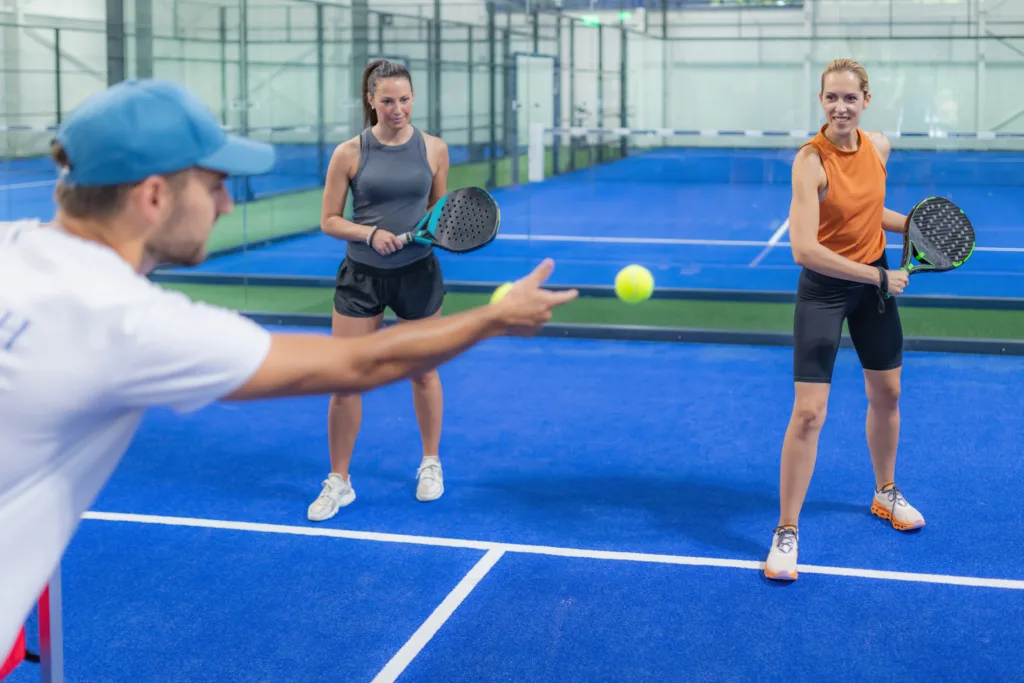While pickleball is easy to learn, mastering doubles strategy separates recreational players from competitive ones. Unlike singles play, doubles requires coordination, communication, and tactical awareness that goes far beyond just hitting the ball back. Whether you’re looking to dominate your local league or simply want to play smarter with your regular partner, these strategic insights will transform your doubles game.
Court Positioning: The Foundation of Great Doubles
The Up-and-Back Formation (Beginner Trap) Many new doubles teams naturally fall into an up-and-back formation, with one player at the net and one at the baseline. While this might seem logical, it creates a significant weakness down the middle and makes it difficult to control the pace of play.
Side-by-Side: The Gold Standard The most effective doubles positioning is side-by-side, whether you’re both at the baseline or both at the non-volley zone line. This formation:
- Eliminates the middle gap that opponents love to exploit
- Allows both players to move forward together
- Creates better court coverage and communication opportunities
The Transition Game The key to winning doubles is moving from the baseline to the net together. This transition should happen after the third shot (your return of the opponent’s serve) when you have time to approach the kitchen line safely.
Communication: Your Secret Weapon
Call the Ball Early and Clearly Silence is your enemy in doubles. Develop clear, consistent communication:
- “Mine!” – You’re taking the shot
- “Yours!” – Your partner should take it
- “Switch!” – You’re changing positions
- “Up!” or “Back!” – Directing your partner’s movement
Pre-Point Communication Before each point, quickly discuss:
- Who’s taking shots down the middle
- Serving strategy and placement
- Any specific tactics for this point
Body Language Matters Your positioning and body language should communicate your intentions to your partner. Lean toward balls you intend to take, and move decisively to avoid confusion.
The Art of the Third Shot
The third shot is arguably the most important shot in pickleball doubles. This is your opportunity to neutralize your opponents’ advantage and get yourself to the net.
Third Shot Drop The most effective third shot is a soft drop that lands in your opponents’ kitchen, forcing them to hit up and giving you time to advance. Key elements:
- Hit with an open paddle face and gentle swing
- Aim for the kitchen, but don’t worry about perfection
- Focus on consistency over placement initially
- Use this shot 70-80% of the time
Third Shot Drive Occasionally, a hard drive can catch opponents off guard, especially if they’re expecting a drop. Use this sparingly and only when:
- Your opponents are standing too close to the net
- You have a clear opening down the line or at someone’s feet
- The court surface or wind makes drops difficult
Mastering the Dink Game
Once both teams reach the kitchen line, the dink battle begins. This is where many points are won and lost.
Dinking Fundamentals
- Keep dinks low and soft, just clearing the net
- Use minimal backswing and follow through
- Aim for your opponent’s feet or slightly off to one side
- Be patient—dink rallies can last 20+ shots
Creating Opportunities The goal isn’t to dink forever, but to force an attackable ball:
- Change pace: Mix soft dinks with slightly firmer shots
- Change direction: Move the ball side to side
- Change height: Occasionally hit a slightly higher dink to change rhythm
- Use angles: Dink cross-court to open up the court
Advanced Positioning Strategies
Stacking Stacking is when both players start on the same side of the court, then move to their preferred positions after the serve. This strategy works when:
- One player is significantly stronger on their forehand side
- You want to keep a left-handed player on the left side
- Your partner has a stronger backhand than forehand
The Erne and Advanced Net Play As you advance, consider these aggressive tactics:
- The Erne: Moving around the non-volley zone to attack a ball from outside the court
- Poaching: Crossing over to take your partner’s shot for a better angle
- Fake poaching: Moving as if you’ll poach to create confusion
Serving and Return Strategy
Serving Deep and Consistently In doubles, the serve should accomplish three goals:
- Land deep in the service box to push returners back
- Be consistent—double faults kill momentum
- Vary placement occasionally to keep opponents guessing
The Power of the Return Your return sets up the entire point:
- Return deep and high to give yourself time to get forward
- Aim for the backhand of the back player when possible
- Avoid hitting returns too hard unless you have a clear advantage
Mental Game and Partnership Dynamics
Staying Positive Doubles partnerships can make or break under pressure. Remember:
- Encourage your partner after missed shots
- Take responsibility for your own errors
- Focus on the next point, not the last mistake
- Celebrate your partner’s winners enthusiastically
Playing to Strengths Understand each player’s strengths and position accordingly:
- If your partner has a weaker backhand, protect that side
- If you’re more aggressive, take more shots down the middle
- Play the percentages based on your skill levels
Adapting to Opponents Great doubles teams adjust their strategy based on their opponents:
- Against aggressive players: Focus on consistency and patience
- Against defensive players: Be more aggressive and create opportunities
- Against unequal partnerships: Target the weaker player early in points
Common Doubles Mistakes to Avoid
The Middle Meltdown Failing to communicate on shots down the middle leads to easy winners for opponents. Establish a clear rule: stronger forehand takes the middle, or player on the right takes anything close.
The Impatient Attack Trying to end points too quickly leads to unforced errors. Build points patiently and wait for clear opportunities.
Poor Court Coverage Not moving as a unit creates gaps. When your partner moves left, you should generally move left too, maintaining your side-by-side formation.
Ignoring Percentages Going for low-percentage shots when high-percentage options are available. Smart doubles is about consistency and strategy, not highlight-reel winners.
Practice Drills for Better Doubles Play
The Dink and Move Drill Practice dinking while moving along the kitchen line. This improves your ability to dink while repositioning.
Third Shot Drop Practice Set up at the baseline and practice dropping balls into the kitchen while your practice partner stands at the net.
Communication Drills Practice calling balls while under pressure. Have someone feed balls randomly between you and your partner.
Conclusion
Mastering doubles strategy takes time, practice, and patience. The teams that succeed aren’t necessarily the most athletic—they’re the smartest, most coordinated, and most adaptable. Focus on communication, positioning, and patience, and you’ll find your doubles game improving dramatically.
Remember, great doubles partnerships are built over time. Find a compatible partner, practice together regularly, and commit to supporting each other through both victories and defeats. The most successful doubles teams aren’t just skilled players—they’re effective partners who trust each other completely.
Ready to put these strategies into practice? Join our doubles leagues and clinics at JoliSports, where you can work with certified instructors to refine your tactical approach and find the perfect playing partner. Your journey to doubles mastery starts here!

